Groceryshop 2018
The Coresight Research team is in Las Vegas this week to participate in Groceryshop 2018, being held October 28–31, which is a new Shoptalk program that will cover the disruption of the grocery, CPG and related industries.The event is being attended by executives from established retailers and brands, startups and technology companies, as well as investors and media professionals.
Topics of discussion at the event will include the transformation of the retail industry (across convenience stores, supermarkets and e-commerce) and changes in the production and distribution processes of CPG across multiple retail verticals. Participants in the event will also discuss the rapid shifts in how today’s consumer discovers, shops and buys, along with the use of new technologies, business models in retail, and the latest trends in consumer behaviors, preferences and expectations.
Below, we note seven key takeaways from the second day at Groceryshop 2018.
1. The Future of Retail is More Digitalized, Collaborative and Experimental, According to Kroger Chief Digital Officer Yael Cosset
In a fireside chat with
Wall Street Journal reporter Heather Haddon, Kroger Group Vice President and Chief Digital Officer Yael Cosset discussed his company’s partnership with Alibaba. He said this partnership is a learning exercise in which Kroger is leveraging the digital channel, rather than physical stores, to fulfill the strong demand for natural and organic products in China.
Cosset told Haddon and the audience that the disruptive changes the grocery market is currently witnessing requires that companies stick to their priorities. Kroger, he said, has deliberately narrowed the scope of its partnerships to ensure high impact on its customer.
Kroger is working to leverage the efficiencies of its 2,800 stores with the 60 million families that shop there and, surprisingly, Cosset said,Kroger’s digital customers spend more time in the stores and visit the stores more frequently than its offline customers.
Cosset said that he sees the grocery store of the future being more experimental. The consumer wants more choices and wants to spend less time selecting what to buy. The food experience will improve, he said, and store layouts and workflows will adjust to reallocate space for fulfillment of omnichannel orders.
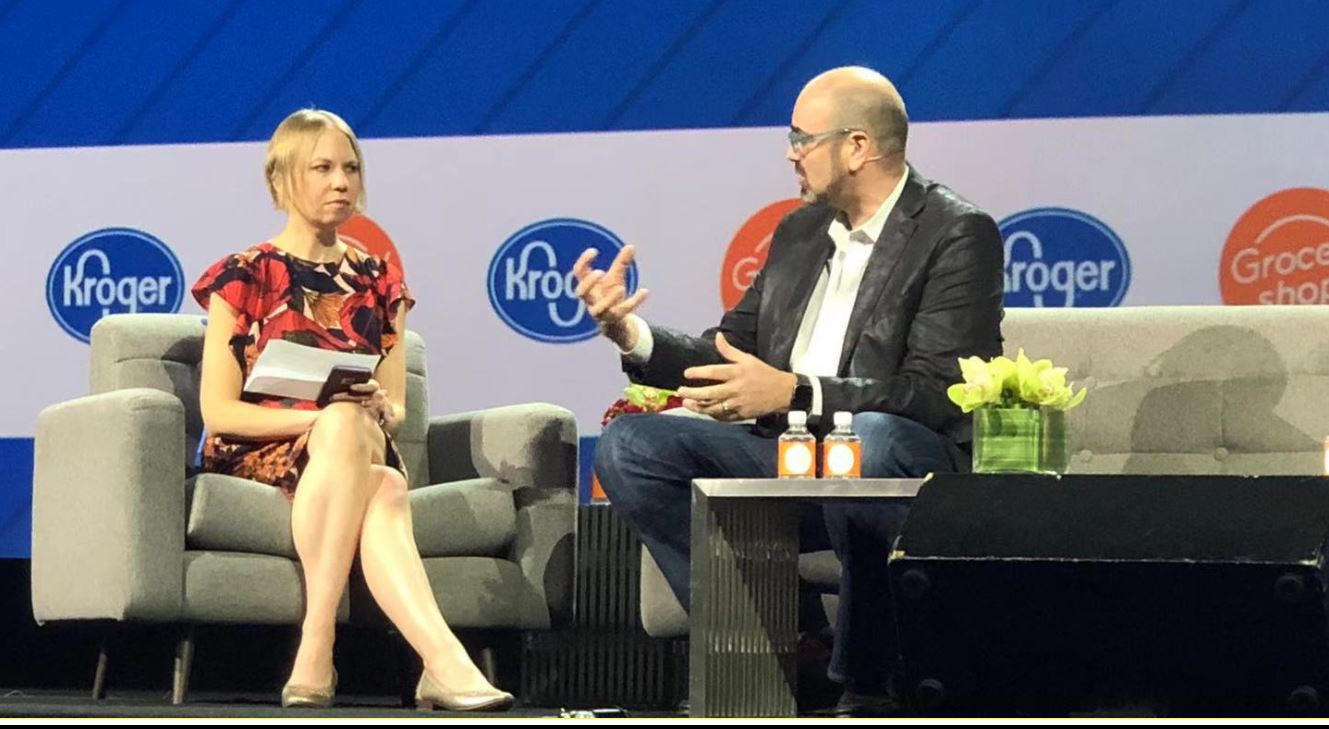 Haddon chatting with Cosset at Groceryshop 2018.
Source: Coresight Research
Haddon chatting with Cosset at Groceryshop 2018.
Source: Coresight Research
2. Takeoff Technologies is Innovating the Last Mile with Local Automated Fulfillment Centers for Grocers
In his presentation, Max Pedró, Cofounder and President at Takeoff Technologies, discussed how grocery products are often perishable and low-value items with low margins, and how this makes order fulfillment and the last mile two of the most complex and challenging parts of grocery e-commerce.
He said that the two most common approaches to online grocery order fulfillment are:
- in-store pick-ups, in which orders are fulfilled in-store by store employees; and,
- building automated warehouses that are often far away from where the shoppers live.
Both the processes have high operating costs, Pedró continued, and said that Takeoff is building automated micro-fulfillment centers right in grocery stores. The company’s solution:
- Makes use of robotic automation to lower order-fulfillment costs (which saves the cost of hiring employees); and,
- Ensures that hyper-local operations lower last mile delivery costs.
Takeoff fulfills online orders by using robots in micro-fulfillment centers. Through a partnership with Knapp, a global provider of fulfillment technology and robotics, supermarkets can use Takeoff’s solution to fulfill orders of up to 60 items in just a few minutes, according to Pedró. The first Takeoff fulfillment center—in partnership with Sedano’s—was launched this October and the company said it has signed another deal with Ahold Delhaize. The company has raised $50 million in funding, Pedró informed the audience.
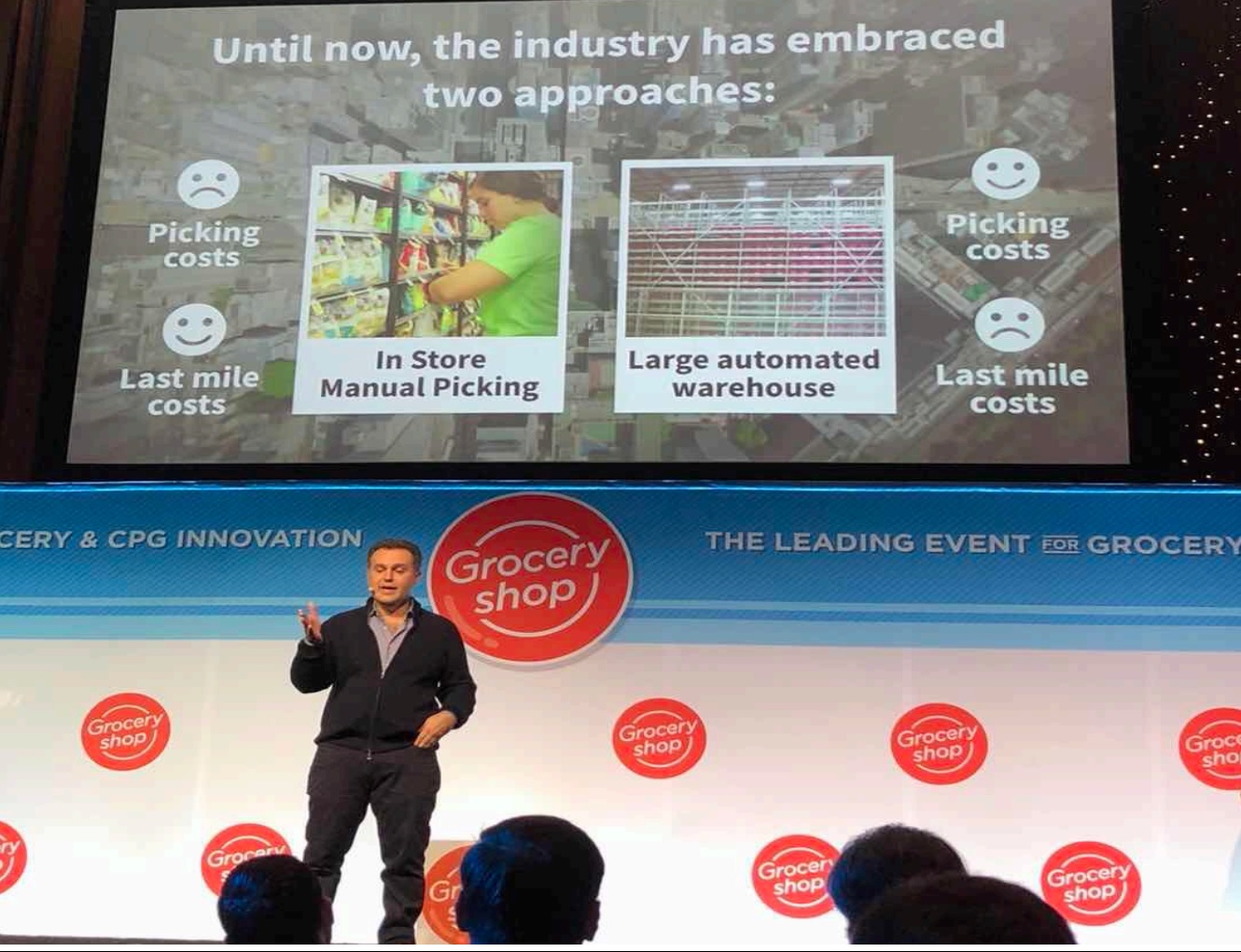 Pedró making his presentation at Groceryshop 2018.
Source: Coresight Research
Pedró making his presentation at Groceryshop 2018.
Source: Coresight Research
3. Curbside is Digitizing Brick-and-Mortar Grocery Fulfillment by Connecting Store Operations and Mobile Commerce
Founded in 2013 and acquired by Rakuten earlier this year, Curbside is helping brick-and-mortar retailers compete with e-commerce companies and food delivery services with click-and-collect, curbside pickup and other omnichannel fulfillment capabilities. The idea is to provide more immediate service to on-the-go customers,said Jaron Waldman, Curbside Cofounder and CEO.
Waldman described the company’s success with its SDK for mobile app offering, called ARRIVE, which delivers accurate and detailed information on users’ trips, maintains constant location statuses and can notify any device or retail system when click-and-collect customers approach the store.
According to Waldman, ARRIVE has several benefits, including:
- Better customer experience by reducing wait time;
- Increased in-store operational efficiency; and,
- E-commerce analytics, arrival and location patterns, store performance and inventory metrics.
CVS, Sephora, Chipotle, Nordstrom, Pizza Hut, Chevron, Boston Market, Westfield, HEB, and Yelp are listed on the Curbside website as ARRIVE customers, and the SDK is used in over 8,000 U.S. locations.
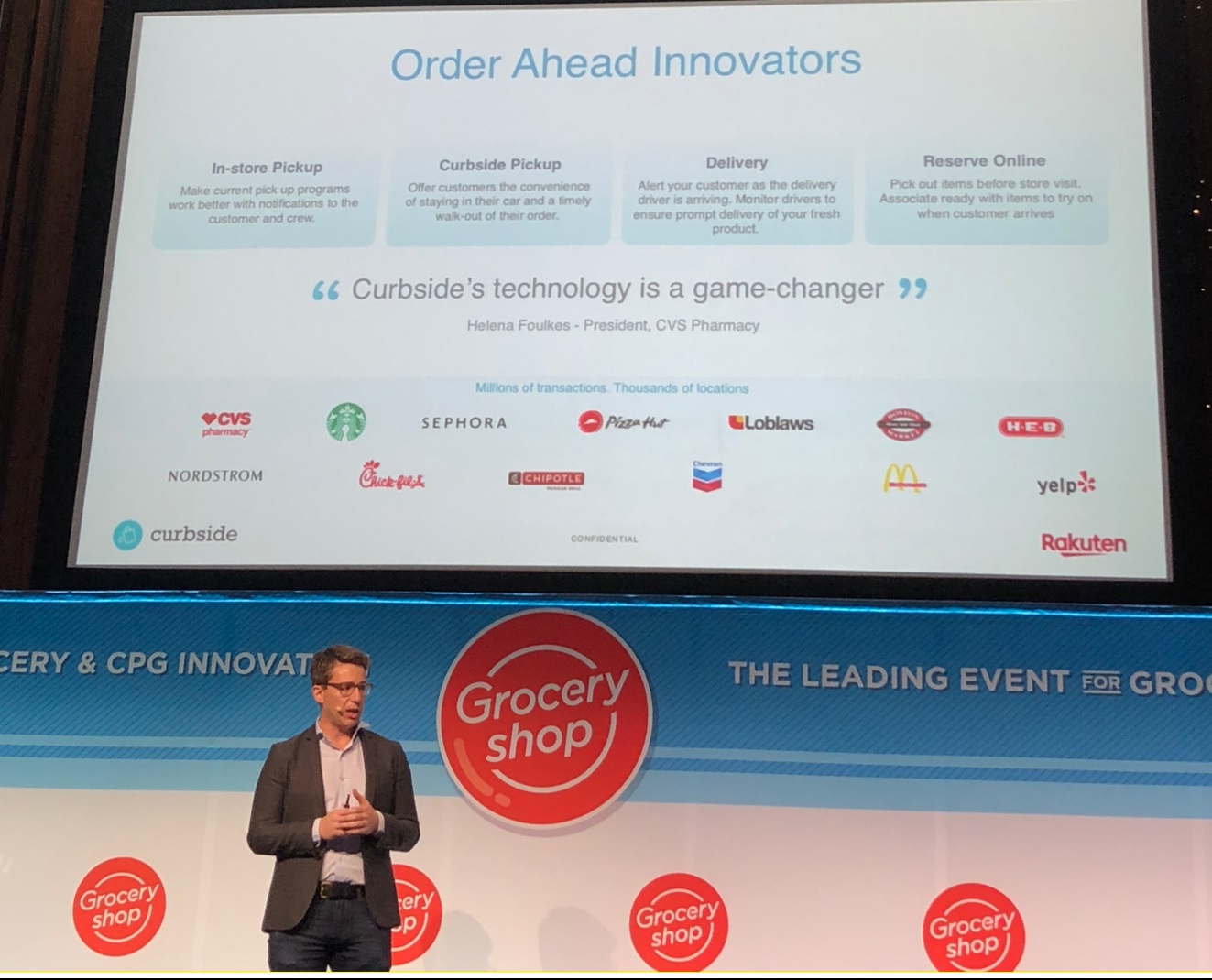 Waldman making his presentation at Groceryshop 2018.
Source: Coresight Research
Waldman making his presentation at Groceryshop 2018.
Source: Coresight Research
4. Blockchain: The New Solution to Food Safety
Walmart has been working with IBM on a food-safety blockchain solution, seeking new ways to efficiently ensure food quality and safety.The company announced last month that all suppliers of its leafy green vegetables for Sam’s and Walmart are required to upload their data to the blockchain by September 2019.
In his presentation, Frank Yiannas, VP, Food Safety at Walmart, said that food transparency was the “achilles heel” of food safety and that blockchain can be leveraged to solve this problem. He said that although it is hard for food tracking the reach the same level as FedEx’s mail tracking, “we are getting close to that level for food.”
Yiannas also discussed the cost–benefit analysis of the blockchain project for food transparency. He said that the significance of food safety makes this project meaningful, and on the cost side, the IBM data entry model has a very-low-to-no-cost advantage. He equated building the food-safety blockchain to building a data-sharing ecosystem, and said that costs can be minimized by involving all stakeholders in this ecosystem. In addition, farmers, who are a crucial part of this ecosystem, are getting tech-savvy with their personal tech devices these days and that makes building the ecosystem much easier.
5. Several Presenters, including Instacart, said that Online Grocery Retail is Alive and Thriving Amidst Changing Consumer Demands
The $1 trillion North American grocery industry has loyal customers that love their local grocers. But busy lifestyles combined with new digital and tech-driven innovations have created new consumer demands and expectations that hinge on convenience, selection and price. Not just product preferences, but modalities of grocery delivery are also changing.
Up from the current 70%, Instacart sees 80% of US consumers using same-day grocery delivery services by the end of 2018 as the company works with 300 retail partners at 15,000 stores to raise consumer expectations. For Apoorva Mehta, Instacart Founder and CEO, the grocery and CPG sectors are currently at a tipping point and within the next five years, one shopper out of every five will shop online for groceries. Compared with the current less than 5% (estimated) penetration of the online grocery market, that growth will be unprecedented, Mehta said, as he reported a 135% year-over-year growth at Instacart.
Mehta went on to say that for online CPG retail, the ability to reach consumers in unique and new ways is a huge opportunity. Sales of CPG products on Instacart rose 200% in the last year and the only way forward for online CPG retail is through creating new partnerships as he has seen many retailers do, he said.
Chieh Huang, Cofounder and CEO of Boxed, the digital warehouse club, agreed with Mehta that brick-and-mortar retail is not dead, especially in grocery,where it is evolving. Price alone will not attract customers, Huang said, convenience and choice of available brands also matter. In contrast with Amazon’s Endless Aisles, Boxed has adopted the strategy of limiting customers’ choice to 2–5 items per category and that has resulted in it getting, on average, 8–10-item orders of $100 value.
Huang also spoke of the blurred lines between DTC CPG companies and retailers. Well-planned distribution marketing will make a difference in the competition to attract customers, he said, and brands and retailers need to evolve.He concluded by saying that a few “strange” alliances are likely to be forged in the grocery ecosystem.
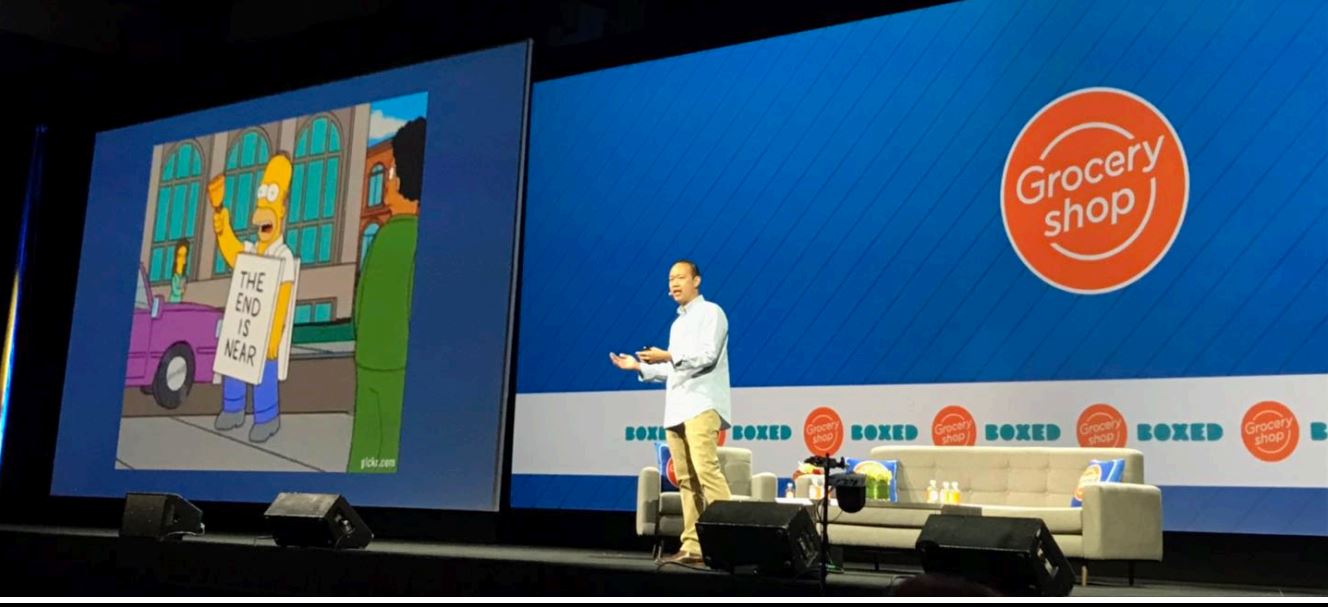 Huang making his presentation at Groceryshop 2018.
Source: Coresight Research
Huang making his presentation at Groceryshop 2018.
Source: Coresight Research
6. Harry’s Continued Success in Walmart and Target; Launches New Shaving Brand for Women and Sees More Opportunity for New CPG Brands
In his keynote presentation, Andy Katz-Mayfield, Cofounder and CEO at Harry’s, the men’s grooming brand, said that consumers are showing a growing preference for tailored and personal offerings and that gives a definite advantage to smaller companies. Harry’s is a community-driven brand that is enhanced with direct consumer–brand interactions on its website and inits online magazine, Five O’Clock, where customers can discover new experiences around masculinity.
Walmart and Target now sell Harry’s products, and Katz-Mayfield said that within the first month of launch at Target, the company was the top seller of non-disposable razors, shave-prep and after-shave products, and face- and body-wash products. The company is now within 1% point of becoming the leading non-disposable razor brand at Walmart, said Katz-Mayfield.
He went on to say that Harry’s is planning to diversify into more consumer goods categories, “We see a massive opportunity to build new brands across CPG.”Harry's recently launched Harry’s Labs, which invests in and develops brands that go beyond men’s grooming products and supports entrepreneurs in building and scaling. Harry’s is using its experience in wholesale and DTC to invest and create new brands such as Hims—an e-commerce wellness brand with skin-care, erectile dysfunction and hair-loss products—and Flamingo, a DTC hair removal and body-care brand for women.
7. Technologies Improve Operational Efficiencies in Every Stage of Retail
Founders of retail innovation companies shared details of how their companies have worked to boost retail efficiency. The four industry professionals who shared their thoughts were:
- On New Products,Nicky Jackson, Founder and CEO of RangeMe, said that“small brands drive most of the growth.” She discussed how RangeMe’s technology helps brands get their items discovered and, at the same time, allows grocery retailers to meet growing customer demands for new brands and products.
- On Store Operations,Francois Chaubard, CEO at Focal Systems, said that “deep learning computer vision is the most scalable way” to make retailers win. Focal Systems’$20-camera helps retailers keep their shelves fully stocked and uses visual recognition to assist customers to check whether an item is available.
- On Pricing and Promotion,David Moran, Cofounderand Chairman of Eversight, said that artificial intelligence is transforming what merchants offer their customers. He described how Eversight’s AI-powered platform help retailers and brands optimize their trade marketing, promotion and price investment.
- On Labor and Workforce Management,Brad Oberwager, Founder and CEO of Jyve, talked about how the company’s platform solves the problem of high employee turnover rate in retail.
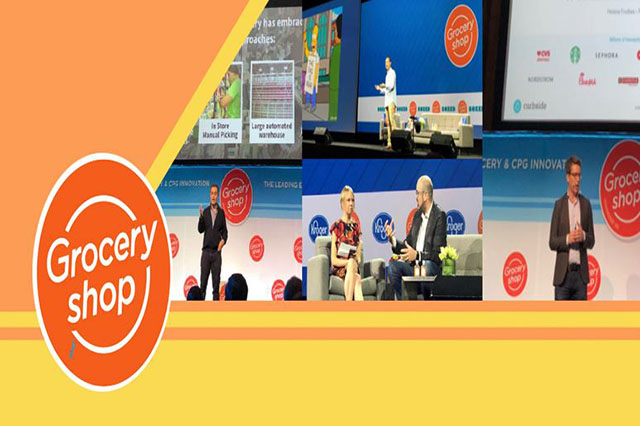
 Haddon chatting with Cosset at Groceryshop 2018.
Source: Coresight Research
Haddon chatting with Cosset at Groceryshop 2018.
Source: Coresight Research Pedró making his presentation at Groceryshop 2018.
Source: Coresight Research
Pedró making his presentation at Groceryshop 2018.
Source: Coresight Research Waldman making his presentation at Groceryshop 2018.
Source: Coresight Research
Waldman making his presentation at Groceryshop 2018.
Source: Coresight Research Huang making his presentation at Groceryshop 2018.
Source: Coresight Research
Huang making his presentation at Groceryshop 2018.
Source: Coresight Research